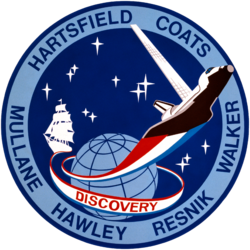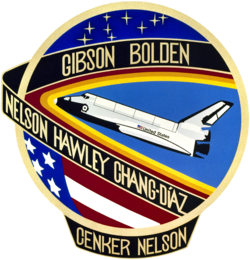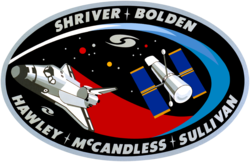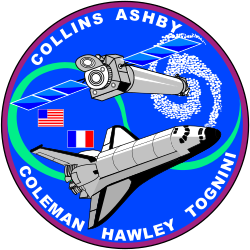Steven Alan Hawley
| Steven Hawley | |
|---|---|
 | |
| Land | USA |
| Organisation | NASA |
| ausgewählt | 16. Januar 1978 (8. NASA-Gruppe) |
| Einsätze | 5 Raumflüge |
| Start des ersten Raumflugs | 30. August 1984 |
| Landung des letzten Raumflugs | 28. Juli 1999 |
| Zeit im Weltraum | 32d 2h 42min |
| ausgeschieden | 27. Februar 2008 |
| Raumflüge | |
Steven Alan Hawley (* 12. Dezember 1951 in Ottawa, Bundesstaat Kansas, USA) ist ein ehemaliger US-amerikanischer Astronaut.
Hawley erhielt 1973 jeweils einen Bachelor in Physik und in Astronomie von der University of Kansas und 1977 einen Doktor in Astronomie und Astrophysik von der University of California, Santa Cruz. Während und nach seinem Studium forschte er an verschiedenen Observatorien.
Astronautentätigkeit
Im Januar 1978 wurde Hawley von der NASA als Astronautenanwärter ausgewählt. Vor der ersten Space-Shuttle-Mission (STS-1) arbeitete er als Simulator-Pilot für die Softwareüberprüfung am Shuttle Avionics Integration Laboratory (SAIL). Für STS-2, STS-3 und STS-4 war er Mitglied der Unterstützungsmannschaften am Kennedy Space Center. Von 1984 bis 1985 war er technischer Assistent für den Direktor der Flight Crew Operations. Von 1987 bis 1990 war er stellvertretender Leiter des Astronautenbüros. Im Juni 1990 wurde er Direktor am Ames Research Center der NASA. Im August 1992 kehrte er zum Johnson Space Center als stellvertretender Direktor für Flight Crew Operations zurück. Ab Februar 1996 trainierte er für die Mission STS-82 nahm danach wieder seine Tätigkeit als stellvertretender Direktor für Flight Crew Operations auf. Von Oktober 2001 bis November 2002 war er Direktor für Flight Crew Operations. Danach war er Associate Director für Astromaterials Research and Exploration Science am Space and Life Sciences Directorate des Johnson Space Centers.
STS-41-D
Bei seinem ersten Raumflug war Hawley Missionsspezialist auf dem Jungfernflug der Raumfähre Discovery am 30. August 1984. Außer dem Kommandanten waren er und die anderen vier Besatzungsmitglieder allesamt Weltraumneulinge. Während der sechstägigen Mission wurden die drei Satelliten SBS-D, SYNCOM IV-2 (auch bekannt als LEASAT 2) und Telstar 3-C ausgesetzt. Außerdem wurden das OAST-1-Solarzellenexperiment und das Experiment CFES-III zur Erforschung des Kristallwachstums durchgeführt. Daneben wurden auch Aufnahmen mit einer mitgeführten IMAX-Kamera gemacht. Mit dem Roboterarm des Shuttles mussten während der Mission gefährliche Eisplatten vom Orbiter entfernt werden.
STS-61-C
Hawley startete am 12. Januar 1986 mit der Raumfähre Columbia zur Mission STS-61-C. Hauptziel der Mission war es, den Kommunikationssatelliten SATCOM KU-1 in seine Umlaufbahn zu bringen. Außerdem wurden zahlreiche kleinere astrophysikalische und materialwissenschaftliche Experimente durchgeführt.
STS-61-J
Diese aufgrund des Challenger-Unglücks abgesagte Atlantis-Mission STS-61-J hätte im Oktober 1986 das Hubble Space Telescope aussetzen sollen. Als Besatzung waren John Watts Young (wäre sein 7. Start gewesen), Charles Frank Bolden, Kathryn Dwyer Sullivan, Bruce McCandless und Steven Hawley eingeplant. Später wurde diese Mission unter einem neuen Kommandanten STS-31.
STS-31
Hawleys dritter Flug begann am 24. April 1990. Hauptaufgabe von STS-31 war das Aussetzen des Hubble-Weltraumteleskops. Daneben wurden mit einer IMAX-Kamera Aufnahmen von der Erde gemacht. Die Discovery landete nach fünf Tagen am 29. April.
STS-82
Mit der Raumfähre Discovery flog Hawley am 11. Februar 1997 zur zweiten Wartungsmission für das Hubble-Weltraumteleskop (HST). Hawley bediente den Roboterarm bei den insgesamt fünf Weltraumausstiegen (EVA), während derer das Teleskop repariert wurde. Neben einem Bandrekorder, der durch einen Kernspeicher ersetzt wurde, erhielt das HST die Infrarotkamera NICMOS und das Spektroskop STIS. Dafür wurden zwei Spektrografen ausgebaut.
STS-93
Am 23. Juli 1999 flog Hawley an Bord der Raumfähre Columbia im Rahmen der Mission STS-93 ins All. Während der fünftägigen Mission wurde das Chandra-Röntgenteleskop ausgesetzt. An Bord der Raumfähre wurden anschließend Experimente auf den Gebieten Biologie, Astronomie, Atmosphärenforschung und Raumfahrttechnologie durchgeführt.
Nach der NASA
Im Februar 2008 schied Hawley aus der NASA aus und wurde Mitglied der Fakultät der University of Kansas.
Privates
Hawley war von 1982 bis 1987 mit der Astronautin Sally Kristen Ride verheiratet. Die Ehe war kinderlos. Er ist in zweiter Ehe mit der ehemaligen NASA-PR-Beamtin Eileen M. Keegan verheiratet.
Siehe auch
Weblinks
- Biografie von Steven Alan Hawley in der Encyclopedia Astronautica (englisch)
- NASA-Biografie von Steven Alan Hawley (englisch; PDF)
- Kurzbiografie von Steven Alan Hawley bei spacefacts.de
| Personendaten | |
|---|---|
| NAME | Hawley, Steven Alan |
| KURZBESCHREIBUNG | US-amerikanischer Astronaut |
| GEBURTSDATUM | 12. Dezember 1951 |
| GEBURTSORT | Ottawa, Kansas |
Auf dieser Seite verwendete Medien
STS-41D Mission Insignia
- The official mission insignia for the 41-D Space Shuttle flight features the Discovery - NASA's third orbital vehicle - as it makes its maiden voyage. The ghost ship represents the orbiter's namesakes which have figured prominently in the history of exploration. The Space Shuttle Discovery heads for new horizons to extend that proud tradition. Surnames for the crewmembers of NASA's eleventh Space Shuttle mission encircle the red, white, and blue scene.
STS-82 Mission Insignia
- STS-82 is the second mission to service the Hubble Space Telescope (HST). The central feature of the patch is HST as the crew members will see it through Discovery's overhead windows when the orbiter approaches for rendezvous, retrieval and a subsequent series of spacewalks to perform servicing tasks. The telescope is pointing toward deep space, observing the cosmos. The spiral galaxy symbolizes one of HST's important scientific missions, to accurately determine the cosmic distance scale. To the right of the telescope is a cross-like structure known as a gravitational lens, one of the numerous fundamental discoveries made using HST Imagery. The names of the STS-82 crew members are arranged around the perimeter of the patch with the extravehicular activity's (EVA) participating crew members placed in the upper semicircle and the orbiter crew in the lower one.
STS-61-c mission patch
- Columbia, which opened the era of the Space Transportation System with four orbital flight tests, is featured in re-entry in the emblem designed by the STS-61C crew representing the seven team members who manned the vehicle for its seventh STS mission. Gold lettering against black background honors the astronaut crewmembers on the delta pattern surrounding colorful re-entry shock waves, and the payload specialists are honored similarly below the sphere.
STS-31 shuttle mission flight insignia. The mission insignia for NASA's STS-31 mission features the Hubble Space Telescope (HST) in its observing configuration against a background of the universe it will study. The cosmos includes a stylistic depiction of galaxies in recognition of the contribution made by Sir Edwin Hubble to our understanding of the nature of galaxies and the expansion of the universe. The STS-31 crew points out that is it in honor of Hubble's work that this great observatory in space bears his name. The depicted Space Shuttle trails a spectrum symbolic of both the red shift observations that were so important to Hubble's work and new information which will be obtained with the HST. Encircling the art work, designed by the crew, are the names of its members.
NASA Astronaut Steven Hawley
Emblem of Nasa's STS-93 mission.
- The STS-93 mission patch, as designed by the five crew members. The STS-93 mission carried the Chandra X-Ray Observatory into low Earth orbit initiating its planned five-year astronomy mission. Chandra is the third of NASA’s great observatories, following the Hubble Space Telescope and the Compton Gamma Ray Observatory. Chandra provides scientists an order-of-magnitude improvement over current capabilities at X-Ray wavelengths. Observations of X-Ray emissions from energetic galaxies and clusters, as well as black holes, promise to greatly expand current understanding of the origin and evolution of our universe. The STS-93 patch depicts Chandra separating from the Space Shuttle Columbia after a successful deployment. A spiral galaxy is shown in the background as a possible target for Chandra observations. The two flags represent the international crew, consisting of astronauts from both the United States and France.





